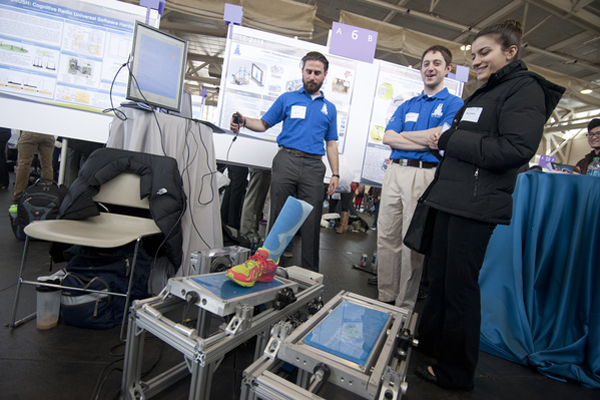Apps, co-ops, startups, and global solutions: It’s RISE:2013

Ever walk by a construction project in the city and wonder what the site will look like one day? Well, a team of seven seniors at Northeastern has created a new app for that.
For their interactive media capstone, the students developed what they call arc—a mobile application that bridges the gap between architects and the public in regard to city planning. Here’s how it would work: Architects upload project specs, and community members walk to the construction site and use an iPad’s camera-view feature to see an augmented reality overlay of the proposed building over the current site. Users could view details like foot traffic, wind patterns, and the building’s shadows throughout the day, and then post feedback directly to the architects.
“You really get a feel for what the project will be like,” said team member Michael Godlewski, who noted that the app’s web version would include several additional features.
The app was one of the many undergraduate, graduate, and faculty research projects on display last Friday at RISE:2013, Northeastern’s innovation, scholarship, and research expo held in the Cabot Physical Education Center. The annual event, sponsored by the Center for Research Innovation and the Office of the Provost, highlights research across many disciplines and showcases the breadth and depth of innovative thinking at Northeastern.
Following the poster demonstrations at the expo, individual projects in seven categories at the undergraduate and graduate level were recognized at an awards ceremony. Of those winners, four student projects earned special RISE Awards that include grants to continue the research. President Joseph E. Aoun and Steven W. Director, provost and senior vice president for academic affairs, presented the awards to the winners, who were determined by an expert panel of judges from Northeastern and industry.
One award went to “arc” in the “Interdisciplinary Topics, Centers, and Institutes” category for undergraduates.
At the ceremony, Tracey Dodenhoff, director of the Center for Research Innovation, noted that one of Northeastern’s greatest strengths is the diversity of thought that exists throughout campus. It’s for that reason that RISE organizers resisted a suggestion from feedback last year to group the posters by category at this year’s event.
“There’s safety in what we know, and it’s comforting to be around people who share our ideas. But innovation takes the courage to put yourself out there with a different perspective, a different opinion, and even sometimes a different truth,” Dodenhoff said. “Transformative innovation takes place inch by inch and day by day by people who are relentlessly curious and have an unbridled vision of what could be.”
Many of the presentations at RISE:2013 featured use-inspired research that addressed global challenges. One created by a group of engineering students was a startup called Filter Light, billed as a low-cost, human-powered, UV water-filtration system for Third World countries. The students got started through Engineers for the Greater Good—a weekend-long competition run by the Northeastern Entrepreneurs Club that challenges students to build a business around a product that addresses a social good. They hope to have a prototype ready next month.
Filter Light earned the undergraduate award in the “Engineering and Technology” category and the special RISE Award in the “Innovation” category.
For his part, Benjamin Greer, a fourth-year architecture student, developed a new sustainable model of coastal urban development for mitigating urban runoff and storm surge contamination. Using Assembly Square in Somerville, Mass., as a testing ground for his model, he proposed converting more than 50 acres of derelict industrial lowland back to its original form as a salt marsh. Salt marshes, he noted, provide some of the most diverse populations of marine species in the ecosystem and act as a filter for runoff pollutants and a drainage system that collects storm water.
Greer said that since the Industrial Revolution, development of urban coastal land has often and unfortunately resulted in unfiltered water runoff and polluted waterways—in this case, the Mystic River.
“The model is not specific to this one site. It fits here in Somerville, but it could be replicated elsewhere,” said Greer, citing Baltimore and Washington, D.C.’s coastlines as examples. His project earned the undergraduate award in the “Humanities and Arts” category and the special RISE Award in the “Scholarship” category.
Many student researchers credited their experiential-learning opportunities at Northeastern for serving as the foundation for their work. Janelle Peiczarka, a combined major in business and political science, found inspiration for her research while on a summer Dialogue of Civilizations program in southern France in 2010 during the global economic crisis. Everyone the group encountered, from politicians to a fruit stand worker in Nice, was feeling the effects.
“Ever since, I wanted to learn more about how countries recovered from these crises in the past,” she said.
So she conducted research on the economic meltdowns of the late 20th and early 21st centuries, identifying strategies that have led to recovery, like responsible fiscal policies and building supportive relationships with international organizations. Then she applied the best practices to a comparative analysis of Iceland and Greece during the global financial crisis and discovered that Iceland’s resilience and Greece’s struggles mirrored her findings.
Third-year chemistry major Rebecca Lewis is working on a research project on co-op at Massachusetts General Hospital in Boston that could lead to earlier diagnosis of Alzheimer’s disease. Lewis is working in the hospital’s Nuclear Medicine and Molecular Imaging Division, where a team of researchers is using position emission topography to test a relatively new hypothesis: that elevated levels of metals in the plaques in the brain could serve as an early signal of the disease.
Prior to her co-op, Lewis began volunteering at the lab last summer and continued working there in the fall for university credit. “Our goal is to make a tracer that we can use for early diagnosis,” she said.





